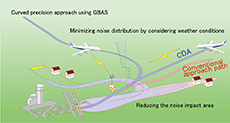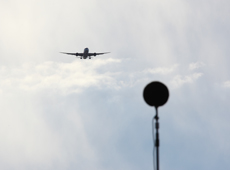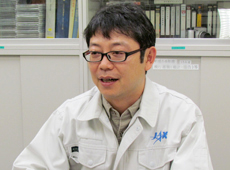
Increased air traffic without increased noise
— Tell us about the DREAMS project's new noise abatement technology.

Concept of noise abatement technology
As the volume of air traffic grows, the noise heard on the ground is also expected to increase. To deal with the problems of aircraft noise, the International Civil Aviation Organization (ICAO) has taken the Balanced Approach. The idea is to address the noise problem by combining four principal elements in a balanced manner, based on the conditions and circumstances of each airport and country. The elements are:
- reduction of noise at source, i.e. building quieter airplanes;
- noise abatement operational procedures, to cut down on noise from individual flights;
- operating restrictions, which restrict limit flights by noisy planes, especially at night;
- land-use planning and management, turning the noise exposure areas into buffer zones by planting forests, etc.
Among these four elements, the DREAMS project has focused on the second one, noise abatement operational procedures.
— Is there a way for aircraft to fly quietly?
Maybe I should say, “We make suggestions for quieter ways of flying." The propagation of sound is affected by atmospheric conditions, such as the direction and strength of wind, temperature, and humidity. For example, sound is more difficult to hear in a strong wind. The way sound travels depends on weather conditions, but the truth is that attempts to reduce aircraft noise haven't really taken weather conditions into account. So we have developed a technology that can predict the diffusion of sound based on weather conditions and determine an approach path that can minimize the impact of noise. Curved precision approach is thought to be feasible with the use of Ground-Based Augmentation Systems (GBAS), which are starting to be introduced in airplanes and airports. If it becomes possible to vary the approach path of aircraft based on weather conditions, we believe that we can prevent further increase in the impact of aircraft noise even if there are more planes in the air. So the DREAMS project has developed a noise prediction program and a approach path optimization program.
Predicting the effect of weather on aircraft noise
— Could you explain the noise prediction program?
Ultimately, we would like to be able to predict aircraft noise, but to do so we first needed to make models that could predict the influence of weather on the way sound travels. Although there are theoretical models of the attenuation of sound over distance, with absorption by air, there were no models that could accurately predict the impact of weather on the propagation of aircraft noise. So we made 273 patterns of different weather conditions, based on the direction and strength of wind, and on temperature. These gave us the vertical distribution of the speed of sound, and allowed us to make prediction models for sound propagation.
To verify the accuracy of these models, we ran tests using a tethered balloon to measure how sound emitted from the sky is propagated on the ground. To be more precise, first we mounted an omnidirectional speaker and a microphone underneath the balloon, and measured the sound, which we had chosen, in the atmosphere. Also, we measured the direction and speed of the wind, the temperature, and the humidity using a sonde ⋅ an instrument that is carried into the atmosphere by a balloon. This way, we were able to link the sound being emitted in the atmosphere, the sound heard on the ground, and the weather conditions at the time. Also, because we wanted to observe the influence of extreme changes in weather, we split testing between November 2012 and July 2013.
— How did the experiment turn out?
 Measuring aircraft noise at take-offs and landings
Measuring aircraft noise at take-offs and landings
We were able to validate the accuracy of the noise prediction models based on different weather conditions. However, this was not the end. We also needed to measure actual aircraft noise for final validation. So with the cooperation of the communities surrounding Narita International Airport, we measured the noise of aircraft taking off and landing at the airport. Noise was measured four times in a year, under different weather conditions, in the four seasons, and we acquired 30,000 data points in total. The result was that the margin of error for more than 90% of the 30,000 data points was within 3 dB, and the accuracy of our prediction models was validated. A margin of error within 3 dB is, in fact, very high accuracy.
Finding the right approach paths to reduce noise
— Tell us about the approach path optimization program?
Using the noise prediction models, we make simulations to determine the quietest approach path. The approach path optimization program calculates, for example, what would happen if a regular flight path were slightly shifted. In an optimum flight path, not only is the position of the aircraft shifted on the horizontal plane, but the aircraft performs a continuous descent approach with minimum thrust. The continuous-descent approach is thought to reduce noise and carbon dioxide emissions. After a number of tests, we have confirmed that, even if air traffic increases by 50%, it will be possible to maintain the current level of noise impact.
— Finally, what is your vision for the future?

For flight operations, there are many aspects to look at other than noise. Adjusting a flight path according to weather conditions in real time requires high-accuracy satellite navigation and precision curved approach technology, which have also been developed by the DREAMS project. Someday, I would like to look at integrating technologies developed by the DREAMS project and by other research institutions. Of course, each airport has different weather conditions and regulations, so I imagine we could adapt our recommendations to meet local requirements. I think our tests to study sound propagation using a balloon and to measure aircraft noise spatially are unique. It may be a good idea to publish our computations and some of our data, so that they can be used in other fields as well. Either way, I would like to enhance our outcomes for the next generation.
Hirokazu Ishii

Leader of the Noise Abatement Technology Section, DREAMS Project Team, Aeronautical Technology Directorate, JAXA
Mr. Ishii graduated from the Department of Aeronautics and Astronautics at the University of Tokyo in 1995, and finished his master's degree at the Department of Aeronautics and Astronautics of the Graduate School of Engineering at the University of Tokyo in 1997. He joined the National Aerospace Laboratory of Japan (now JAXA) in 2000, and has been in his current position since May 2012.
[ April 1, 2015 ]
